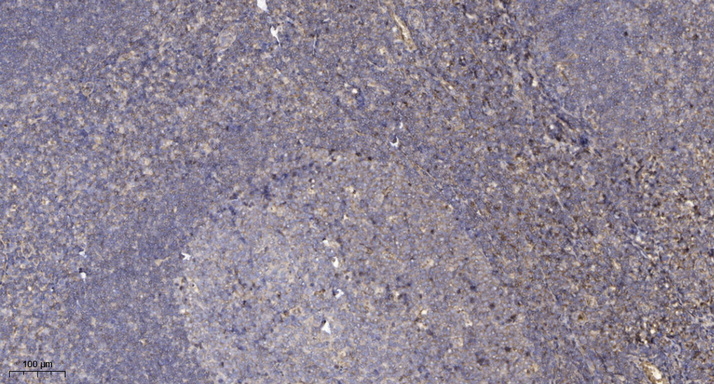PKAα cat (phospho Ser338) Polyclonal Antibody
- Catalog No.:YP0963
- Applications:IHC;IF;ELISA
- Reactivity:Human;Mouse;Rat
- Target:
- PKA
- Fields:
- >>Endocrine resistance;>>MAPK signaling pathway;>>Ras signaling pathway;>>Calcium signaling pathway;>>cAMP signaling pathway;>>Chemokine signaling pathway;>>Oocyte meiosis;>>Autophagy - animal;>>Longevity regulating pathway;>>Longevity regulating pathway - multiple species;>>Adrenergic signaling in cardiomyocytes;>>Vascular smooth muscle contraction;>>Wnt signaling pathway;>>Hedgehog signaling pathway;>>Apelin signaling pathway;>>Tight junction;>>Gap junction;>>Platelet activation;>>Circadian entrainment;>>Thermogenesis;>>Long-term potentiation;>>Retrograde endocannabinoid signaling;>>Glutamatergic synapse;>>Cholinergic synapse;>>Serotonergic synapse;>>GABAergic synapse;>>Dopaminergic synapse;>>Olfactory transduction;>>Taste transduction;>>Inflammatory mediator regulation of TRP channels;>>Insulin signaling pathway;>>Insulin secretion;>>GnRH signaling pathway;>>Ovarian steroidogenesis;>>Progesterone-mediated oocyte maturation;>>Estrogen signaling pathway;>>Melanogenesis;>>Thyroid hormo
- Gene Name:
- PRKACA
- Protein Name:
- cAMP-dependent protein kinase catalytic subunit alpha
- Human Gene Id:
- 5566
- Human Swiss Prot No:
- P17612
- Mouse Gene Id:
- 18747
- Mouse Swiss Prot No:
- P05132
- Rat Swiss Prot No:
- P27791
- Immunogen:
- Synthesized phospho-peptide around the phosphorylation site of human PKAα cat (phospho Ser338)
- Specificity:
- Phospho-PKAα cat (S338) Polyclonal Antibody detects endogenous levels of PKAα cat protein only when phosphorylated at S338.
- Formulation:
- Liquid in PBS containing 50% glycerol, 0.5% BSA and 0.02% sodium azide.
- Source:
- Polyclonal, Rabbit,IgG
- Dilution:
- IHC 1:100 - 1:300. ELISA: 1:5000.. IF 1:50-200
- Purification:
- The antibody was affinity-purified from rabbit antiserum by affinity-chromatography using epitope-specific immunogen.
- Concentration:
- 1 mg/ml
- Storage Stability:
- -15°C to -25°C/1 year(Do not lower than -25°C)
- Other Name:
- PRKACA;PKACA;cAMP-dependent protein kinase catalytic subunit alpha;PKA C-alpha
- Molecular Weight(Da):
- 41kD
- Background:
- This gene encodes one of the catalytic subunits of protein kinase A, which exists as a tetrameric holoenzyme with two regulatory subunits and two catalytic subunits, in its inactive form. cAMP causes the dissociation of the inactive holoenzyme into a dimer of regulatory subunits bound to four cAMP and two free monomeric catalytic subunits. Four different regulatory subunits and three catalytic subunits have been identified in humans. cAMP-dependent phosphorylation of proteins by protein kinase A is important to many cellular processes, including differentiation, proliferation, and apoptosis. Constitutive activation of this gene caused either by somatic mutations, or genomic duplications of regions that include this gene, have been associated with hyperplasias and adenomas of the adrenal cortex and are linked to corticotropin-independent Cushing's syndrome. Altern
- Function:
- catalytic activity:ATP + a protein = ADP + a phosphoprotein.,enzyme regulation:Activated by cAMP.,function:Phosphorylates a large number of substrates in the cytoplasm and the nucleus.,PTM:Asn-3 is partially deaminated to Asp giving rise to 2 major isoelectric variants, called CB and CA respectively.,similarity:Belongs to the protein kinase superfamily.,similarity:Belongs to the protein kinase superfamily. AGC Ser/Thr protein kinase family. cAMP subfamily.,similarity:Contains 1 AGC-kinase C-terminal domain.,similarity:Contains 1 protein kinase domain.,subcellular location:Translocates into the nucleus (monomeric catalytic subunit) (By similarity). The inactive holoenzyme is found in the cytoplasm.,subunit:A number of inactive tetrameric holoenzymes are produced by the combination of homo- or heterodimers of the different regulatory subunits associated with two catalytic subunits. cAMP ca
- Subcellular Location:
- Cytoplasm. Cell membrane. Nucleus . Mitochondrion . Membrane ; Lipid-anchor . Translocates into the nucleus (monomeric catalytic subunit). The inactive holoenzyme is found in the cytoplasm. Distributed throughout the cytoplasm in meiotically incompetent oocytes. Associated to mitochondrion as meiotic competence is acquired. Aggregates around the germinal vesicles (GV) at the immature GV stage oocytes (By similarity). Colocalizes with HSF1 in nuclear stress bodies (nSBs) upon heat shock (PubMed:21085490). .; [Isoform 2]: Cell projection, cilium, flagellum . Cytoplasmic vesicle, secretory vesicle, acrosome . Expressed in the midpiece region of the sperm flagellum (PubMed:10906071). Colocalizes with MROH2B and TCP11 on the acrosome and tail regions in round spermatids and spermatozoa regardle
- Expression:
- Isoform 1 is ubiquitous. Isoform 2 is sperm-specific and is enriched in pachytene spermatocytes but is not detected in round spermatids.
- June 19-2018
- WESTERN IMMUNOBLOTTING PROTOCOL
- June 19-2018
- IMMUNOHISTOCHEMISTRY-PARAFFIN PROTOCOL
- June 19-2018
- IMMUNOFLUORESCENCE PROTOCOL
- September 08-2020
- FLOW-CYTOMEYRT-PROTOCOL
- May 20-2022
- Cell-Based ELISA│解您多样本WB检测之困扰
- July 13-2018
- CELL-BASED-ELISA-PROTOCOL-FOR-ACETYL-PROTEIN
- July 13-2018
- CELL-BASED-ELISA-PROTOCOL-FOR-PHOSPHO-PROTEIN
- July 13-2018
- Antibody-FAQs
- Products Images

- Immunohistochemical analysis of paraffin-embedded human tonsil. 1, Antibody was diluted at 1:200(4° overnight). 2, Tris-EDTA,pH9.0 was used for antigen retrieval. 3,Secondary antibody was diluted at 1:200(room temperature, 30min).



